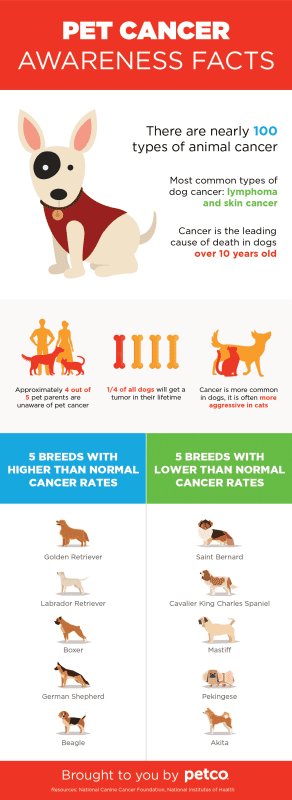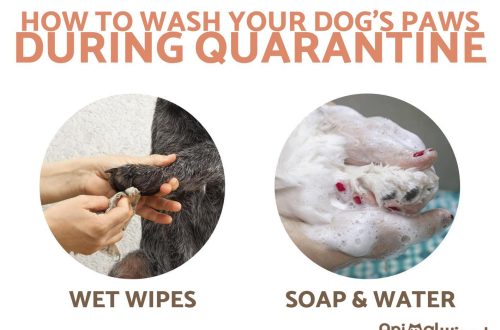
All about Canine Cancer
Many people are surprised to learn that cancer in dogs is a huge problem. An Italian study for the journal BioMed Central Veterinary Research showed that out of 100 dogs, approximately 000-800 will develop this disease. At the same time, animals older than 900 years and purebred pets are at greater risk compared to mixed breeds.
Tumors in dogs appear in the same way as in humans, reducing their quality of life and its duration. Today, however, there are many different treatments available, and veterinary research continues to increase every pet’s chances of a long and happy life. How to identify signs of cancer in a dog and how to care for it – further.
Contents
Forms of Cancer in Dogs
Tumors in dogs can affect any organ. Signs of oncology in a dog by external signs, that is, on the skin, are usually easy to detect. However, cancers of the breast, brain, abdomen, or blood are much more difficult to detect. According to the American Animal Hospital Association (AAHA), the most common cancers in dogs include:
- Lymphoma. Cancer of the lymph nodes that affects the immune system.
- Hemangiosarcoma. Cancer of the blood vessels.
- Mast cell tumor. A cancer that can develop almost anywhere but often presents as skin lesions.
- Melanoma. Aggressive skin cancer that can develop in the mouth, eyes, or paw pads.
- Osteosarcoma. Malignant bone cancer that is most common in large dogs.
- breast carcinoma. A breast tumor that can often be prevented by spaying a dog at an early age.
Signs of Cancer in Dogs
The symptoms of oncology may differ depending on which system the cancer affects, and whether the tumor is benign and solitary or malignant. It also matters how quickly it spreads to distant parts of the body.
For example, a lipoma, a common benign fatty tumor, is a soft, mobile lump under the skin. On the other hand, mast cell tumors can appear as red bumps on the skin, similar to allergies. Hemangiosarcoma, a tumor that develops from cells lining blood vessels, may appear as skin tumors or spread to the spleen. In some cases, it can also occur in the spleen, as a result of which it becomes large, bumpy and fragile.
It is necessary to carefully monitor the condition of the pet if it seems that he is ill. Lameness, a swollen paw, or excessive licking of a limb can indicate bone cancer, and a brain tumor can cause behavioral problems or seizures.
Knowing how the mouth, paws, neck and joints of the dog normally look, you can more likely identify anomalies. For example, melanoma can show up as a dark spot in a dog’s mouth or a swollen paw. The AAHA writes that the first sign of lymphoma is often an enlargement of one or more lymph nodes in a dog’s neck or knees.
Malignant cancer in animals usually causes unexpected weight loss, which may be the only noticeable symptom. If the owner suspects the pet has cancer, call the veterinarian and schedule the dog for a checkup as soon as possible.
How is Cancer in Dogs Treated?
Cancer in dogs is a common problem, and there are currently many treatment options for this condition. Because cancers in animals and humans are very similar in nature, much of the human cancer research has already been tested in dogs. Almost all human cancer treatment options are available for four-legged pets.
Cancer treatment in dogs depends on the type of disease and how likely it is to spread. If the tumor is malignant, treatment and prognosis will depend on how far it has spread. The location of the disease in a pet can also affect the course of treatment chosen by the veterinarian.
Many correction methods work synergistically, that is, they complement each other. They are more effective in fighting cancer together than individually. In such a case, the veterinarian or veterinary oncologist may prescribe any or all of the following treatments:
- surgical removal of a cancerous tumor;
- radiation therapy to kill remaining cancer cells;
- complex treatment with anti-cancer drugs, better known as chemotherapy (dogs tolerate chemotherapy well – they rarely feel sick, and their hair almost does not fall out);
- immunotherapy in the form of cancer vaccination to strengthen the immune system against invading tumor cells;
- stem cell transplantation in dogs diagnosed with blood cancer.
There is hope: how long dogs with cancer live
If a pet is diagnosed with cancer, it is important to remember that there are currently many methods available to treat and even cure cancer in four-legged patients.
Many owners choose not to treat their pets, thinking that the treatment will cause them discomfort. But animals tend to tolerate cancer treatment much better than most people. This is partly due to the fact that they do not understand what is happening. It can be scary to take a dog for treatment, but she usually sees it as a routine trip to the veterinary clinic, where everyone treats her nicely and treats her to dog treats.
If a pet is diagnosed with cancer, it is necessary to listen to the treatment options offered by the veterinarian and choose the most optimal one. Organizations such as the National Canine Cancer Foundation will help connect with other pet owners who are undergoing cancer treatment. Such contacts will help to get advice and necessary support.
If the disease is detected at an early stage, it will be easier to treat it. Therefore, it is important to take your pet to the veterinarian for examination at least once a year so that early intervention can be carried out if it is suddenly needed. Removing one “harmless” bump can give your pet many more happy years.
See also:
- Why does a dog snore or sleep restlessly
- Brain Aging Signs in Dogs and Treatment
- The most common dog diseases: symptoms and treatment
- Do dogs get jealous?





